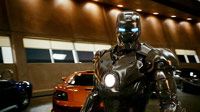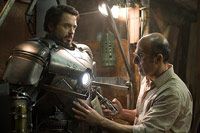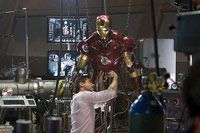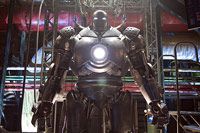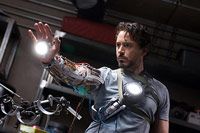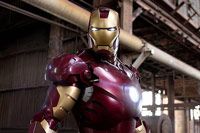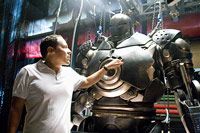We head to Stan Winston Studios for an up-close and personal look at the Iron Man AND Iron Monger suits
With the Iron Man DVD and Blu-Ray release coming up on September 30, the fine folks at Stan Winston Studios decided to let a few online journalists into their midst for a glimpse at some of the machinery from this summer blockbuster. We were originally just going to see the ginormous "Iron Monger" suit, which Jeff Bridges steps into, but we were informed while talking with Stan Winston protoges key artist Chris Swift and model shop superviser Dave Merritt, who both supervised the suits' construction, that the Iron Man Mark II suit had just come back into the studios today. The Mark II suit is the all-silver version of the suit, with the Mark I being the crudely-constructed version Robert Downey Jr.'s Tony Stark constructs in captivity, and the final Mark III suit being the smashing maroon and gold suit we beame so fond of. They had sent the Mark II suit out on tour, so to speak, and it had just come back to the Van Nuys studio. But, before we got to see all of that, we all got to have a little chat with Swift and Merritt - right in their "board room" which houses an amazing array of practial models from such filmes as Edward Scissorhands, Predator, "Jurasic Park", "Terminator 2" and one that appeared to be from the upcoming film The Wolf Man, along with the Mark I suit - about their amazing efforts with this now-iconic Iron Man suit. Here's what the two had to say.
Chris Swift and Dave Merritt
We heard you talking earlier and the Mark III suit was not always going to be a practical suit? Is that the story?
How did you do it?
Chris Swift: (Laughs) We were asking ourselves the same question. 'How did we do that?' It really did seem like an impossible task. I have to say, for the most of us, it seemed like an impossible task.
Dave Merritt: The directive from Marvel was really to put the emphasis on this being a superhero. The idea of putting somebody in there wasn't as important to them, so once we nailed down that design from Phil Saunders, and moved on to building a 3-D model, we were able to start taking scans of the bodies we started to line up and through that process we were kind of be able to get an idea that this might work, this might go. Meanwhile, as they were working out their budgets for digital, they came to the realization that whatever we could get practically, could only help the movie and they started embracing all of that.
Chris Swift: I would love to say that, since we're pretty seasoned in doing a lot of suit work and things like that, we would just make this and go on our expertise and our talents. But there were many many nights, I have to tell you, where we were here late and just pulling our hair out going, 'It's not going to work. How are we going to do this?'
Dave Merritt: It was so tight.
Dave Merritt: But we did start out using robots, in a way. We utilized a lot of graphic phototyping processes here as a tool for us to get our job done. When we started getting into actually fabricating the Mark III, once we had all our patterns, in the model we started refining the surfaces and really treating it like an automotive body, a car, making sure all the lines are nice and clean.
(At this point, one of the staffers came in and informed us that the Mark II had arrived.)
Dave Merritt: Oh, excellent.
Chris Swift: Is it intact? Does it have a head?
(Laughs)
Chris Swift: Every time we send out these things, no one ever wants to pay for us to go out there and set it up and tear it down and bring it back. They come back always broken. It's like, 'Did you guys actually send a head with it?'
Dave Merritt: Or 'The light doesn't work.'
Where is it coming from?
Dave Merritt: It was at the costume show at the Metropolitan in New York. It was there for the last two or three months.
With a character like this where there have been so many designs and suits, how did you come upon the variation that you have chosen for the final design of the suit?
Dave Merritt: Once we got a hold of our 3-D models, we worked with Phil to make some modifications so we could start to realize how joints would truly move and how some of the plates were going to open up, how the hips were going to work so they wouldn't crash into each other. So, we'd make those modifications. We just kind of went through that process for about two or three weeks so we came up with something they were happy with.
Do those practical logistics make substancial changes in the visuals?
Dave Merritt: They were small enough so you wouldn't notice.
Chris Swift: We paid close attention to make sure that was the case because when they bought off on the design, a little movement wouldn't make a big difference.
Dave Merritt: The only one change was Chris adusted the head a little bit.
Looking back, how do you think the fans would've reacted if it was a digital suit. The fans really reacted to the actual practical suit, so how do you think they would've reacted if it was a digital suit?
What was it like for the actual stuntmen in the suit? I read that one of them fell down and he was afraid that he broke it.
Chris Swift: Mike Justice, I would have to say, was, for the most part, when you don't see Robert Downey actually lifting the head up, it's pretty much Mike Justus. We had Oakley Lehman in there as well, but it was Mike that fell. He said he fell like a sack of potatoes. He just went straight down. He made one misstep and he just couldn't stop. He stopped, but the suit kept going.
Dave Merritt: We switched Mike and Oakley out. You could only be in the suit for about three hours before you just got tired. There's a real difference between having an 80-pound backpack on. You can do that, but when you have 80 pounds wrapped around you, and it's clunky, it's a totally different animal.
Chris Swift: For our purposes, it really wasn't on purpose, but it really worked out to our advantage, that even if it was the Mark III, when at that point in the movie where he's in the Mark III and he's going out and doing all these things, Jon (Favreau) is very good about keeping things organic and realistic. He never came to us, like in a lot of movies, and said, 'I want this to be always pristine and shiny.' So, if it gets a knick and it gets a scratch and it falls down, continuity might be a problem, but if it's got a knick, it's OK. It's an Iron Man suit and it does get knicked and it not only shows reality, but it shows vulerability, which is important to the storyline, because if you think that he's just invincible, then what's the point of the whole idea? That really helped us out, the fact that we could expand upon when suits would get broken and knicked up we ran with it. We allowed it to be a part of the suit and the look of the suit, so that helped us out.
Have you guys been talking about what to do new for the next one, which people are already talking about?
In the 70s, Iron Man had roller skates. Could we see him in roller skates in the next one?
Chris Swift: There is talks about an Iron Chimp that has roller skates and smokes cigars.
(Laughs)
Chirs Swift: I don't know if it's going to happen, but I for one am looking forward to that.
That's a DVD extra right there.
Chris Swift: Exactly.
You guys talked about the difficulty in building these suits and the timeframe specifically, but in terms of what you've done before, where does this rank as a challenge?
Chris Swift: As far as building time and all of that? I would say it's about par with everything we get these days. No time, no budget. What would you say?
Dave Merritt: Well, for me, it was a challenge. I would say it would be right up there among the top three of tough ones. Just the logistics of it all was really challenging and the timeframe was really pretty standard for a lot of the films we get these days. I think what we ended up having to do, in the long run, would put it in the top three.
What would be the other two, off the top of your head?
Chris Swift: Probably the last three movies we worked on (Laughs).
Is that sort of how it always is in this business? That the next project is always the hardest project?
Chris Swift: It can be. It usually depends on how much we're doing for the movie. Sometimes we just get one small character we can focus on. Other things, like Iron Man, we had to build so much more. We not only had to build one Iron Man suit, but three different types of Iron Man suits and then we had to build an Iron Monger. I give all the credit to Dave, to expand upon what he's saying, these suits were built piece by piece, as opposed to when we do a more organic thing like a monster, we'll sculpt the whole thing and hands might be separate and head might be separate. We'll break it down in that sense, but for the most part, we have a large majority of it that's one part, once we sculpt it and get it molded, we run it as such and paint it as such. These were all separate part pieces, putting the whole suit together and it really had to be built that way.
Dave Merritt: For the Mark II and Mark III, there were well over 80 pieces in the suit. We had to figure out how it was going to move, how it was going to fit, how it was going to move within it, and then there was the undersuit and filling the joints in between.
Chris Swift: There were two factors that I looked at, especially in the Mark II and Mark III, basically they're the same suit, which is Dave's team did such an awesome job of taking all those pieces and making them so pristine and beautiful, to the eye, they're just perfect pieces. At the same time, the aesthetic thing is one thing, but on the other hand, how do we make it all work. There was engineering that, taking those parts of those beautiful pieces and trying to figure it out. There would be re-cutting and re-engineering and Dave's team would have to go back and re-work another thing and make it beautiful again after we cut out a certain part.
There has been a trend in these films that these elements all have to be grounded in some sort of practical reality. What is more of the challenge for you guys? Is it something like this where there is a layer of realism to it, or is it when you have complete freedom to do whatever you want?
Chris Swift: As making it or as in liking it as a fan?
Both, actually.
Dave Merritt: A lot of that is in the filming too, the camera angles and how they approach it.
Chris Swift: This particular suit, and I'll say from my own personal thing, I'm very proud of that came out of the studio. When you see it in person, it works from every angle, from every shot. It just looks like the real thing. I don't look at any part of it and go, 'We could've done better. We failed in this part. It could've looked better at this angle.'
Dave Merritt: The first camera test we went to, everybody was there. We put it on and we do the camera test and when everybody saw it, they were just blown away, by actually seeing it for the very first time, seeing Iron Man walking. They were very excited. The next day we went down for the screening and we all took our notepads and we were all in this trailer screening and the first time we saw Iron Man, Favreau goes, 'That's our guy.' He just gets that look and he was so excited. We walked out of that screening room without one single note on our pad.
Chris Swift: I will add to the story that the funny part I remember was that Shane was such a showman, he had such good showmanship, that when we were putting the suit on him, we had him in a tent. When he walked out, he walked out full. You've gotta remember, this test, we were so not ready for this test. He walked out of that tent and everybody just went, 'Oh my God. That's it.' Until he took about 10 steps and eight pieces fell off. Jon was like, 'You guys, you did it. You did an amazing job. But those parts are going to stay on when we're filming.' That was pretty funny.
They're talking about a release date of 2010 for Iron Man 2. Are you guys worried about being on another tight schedule?
Dave Merritt: No. These days, it's just the way we have to approach it. We just have to approach it fast and furious.
Chris Swift: We always know it's going to be tight, as far as time-wise and budgetary, it's always going to be tight. That's just how it is. I think the things that become the worry is that, we do this as artists and we want to do things that we're proud of, not only for the producers and actors, but we do it for ourselves. We don't want to put out soemthing we're not proud of, so we always worry about the fact that we don't have the time to do something that we're not going to be proud of.
With the passing of Stan this year, there was a lot of talk about the end of an era, and in a lot of ways it is. I think that a lot of people maybe meant it that the practical effects era was on its way out. Do you guys think that practical effects will be as strong in the 21st Century?
Dave Merritt: Oh yeah, I think so. I mean, digital is a great tool and it helps us a lot. It makes our jobs easier. It's one of the reasons we're able to build things as quickly as we do, because we know that we'll be able to get away with certain things. Everybody loves practical. It just looks right, it looks real and even digital loves it because it makes their job easier as well.
You were working on Avatar with James Cameron, who was kind of leading the drive to digital filmmaking and all that kind of stuff, but the fact is that he's still integrating practical effects still says something.
The impression is that it's a green-screen movie with people in ping-pong ball (motion-capture) suits. Are there practical elements on those sets?
Dave Merritt: Well, we really shouldn't say.
They did mention at this point that we could talk to John Rosengrant, who "would be the guy to talk to" about Avatar. Sadly, after our day had ended, he was "out to lunch," we were informed. However, there was more from this day, much more indeed.
After our little chat, we were lead through the innards of the studio and could see people working on various effects in a big workshop. There were also, in the hallways, some pieces of models and full-blown models, like one from "Terminator 2" towards the end of the film where you can see the metal exoskleton underneath the Governator's chiseled face. We were then lead into a large room and what stood before us was one of the coolest things I'd ever seen in person: the Iron Monger suit, which stood a good 12 feet tall or so, by my estimate. I wish I had a camera with me to show you this amazing specatcle (I'm still waiting on mine to be shipped, sadly) but it was quite a sight to behold. Also, to the left of this huge structure was the Mark II Iron Man that we were told earlier had arrived. While that did look pretty damn cool, everyone was in sheer awe of this monstrosity and then Swift and Merrit talked a little more about this huge Monger.
Chris Swift and Dave Merritt - Part II - Iron Monger
Chris Swift: The way you see it in the movie, was actually the way it was built. The front panel in the chest here does come down and Jeff Bridges did get inside. There was actually a seat. We had two of them, two different versions of them, but they both looked the same, for the most part. When we had Jeff in it, it's really interesting. Being a part of shooting the movie on set, there was so much of what we did on set that either never made it in the movie or either got restructured. At the end of the movie, where the suit of the Iron Monger gets low on power and he just falls through, when we shot it, he actually gets caught up in the cage. There's a big long scene - I don't know if they have this on the DVD or not - but there's a big long scene where Robert is talking to him and they go through this big heartfelt thing about how things have changed through knowing his father and all of that. It's a big long scene that doesn't happen in the movie the way you see it.
Dave Merritt: Iron Monger was a reference piece.
(Laughs)
Dave Merritt: They wanted to matches from it and highlights and the spectrum.
Chris Swift: The interesting thing about it, I would say for Dave's part, was, luckilly, as it was built as a reference piece, luckily, they wanted it posable. So, instead of it just being a static piece, it did have movable joints that could be locked into position and posed.
Dave Merritt: Now, Shane had the foresight, he said, 'We should really put points on these so we could puppetteer it.' So, we went just that next step further, which wasn't asked for, but we did that and made everything movable.
(Dave then showed us how everything moved, rotating the waist, arms and fingers for us. We were still dumbfounded at its coolness.)
Movie PictureChris Swift: The Iron Monger, even though he's not made of metal, he's very heavy. Being one of the guys who ended up puppetteering the arms on this character, it was really tough to do. During one of the interesting shots in the movie that I was really proud of as a practical shot, when Robert is kind of hanging off the railing and the Iron Monger spins around and shoots a missile and, because his guidance has been knocked out by Tony Stark, he misses and hits a wall behind him. It was all a practical shot, in fact none of it was digital. Even the rocket itself. They strung a line all the way to the wall and the pyrotechnician guys were behind and they just shot it down the line. The hard thing was the line was way up here and I was on the arms and the task was that while Jeff was shouting his lines, the Iron Monger had to spin around, raise his arm and fire and not only that, the arm had to be right in line with where that wire was. That wire was way up there and trying to get that arm up there was so hard and heavy to do. I just prayed to God that we got it on the first shot because I was done. We did it twice, but after the first time, my muscles were just quivering.
From the design process to the building process, to what degree do you know what every single thing does? Does each piston have a purpose or what's designed for aesthetics and what's planned as in functionality?
Dave Merritt: We were handed this design by production and it was pretty complicated, at that point. It was the design, it wasn't an engineered robot. We had to go in and, through our 3-D modeling process, start to change some of the joints, trying to get the pistons to line up so they'd move around. In the 3-D modeling is where we really worked through that and we were able to put the model through motions so we would actually see what it was doing before the application process. We even did that with the Mark III. That just helps us out to field some of those problems.
After that, our day was done and sadly we all had to part ways with Mr. Swift and Mr. Merritt and their astonishing collection of models they had on display. The whole thing was quite a sight to behold, my friends and I'm glad I was there to catch a glimpse of these amazing machines and get some insight into the men who brought them to life. That's all from Stan Winston Studios, but look for some pieces in the very near future delving deeper into Iron Man with Marvel Comics legend Stan Lee, director Jon Favreau and a trip up to ILM for some digital magic from this film. Peace in. Gallagher out!
Dont't forget to also check out: Iron Man [2008] [WS] [Ultimate Edition] [2 Discs] [O-Sleeve], Iron Man [Blu-ray]

